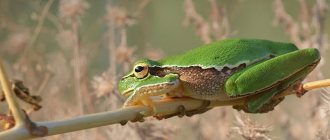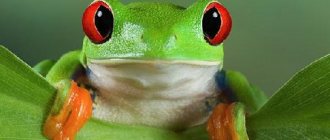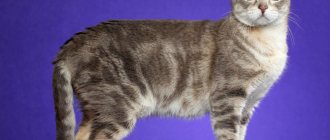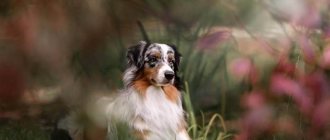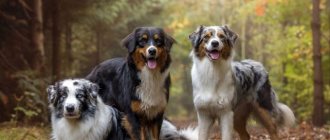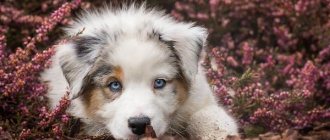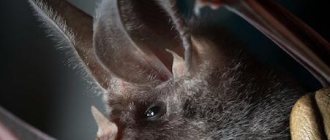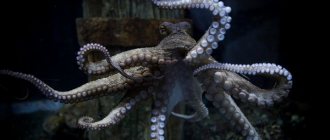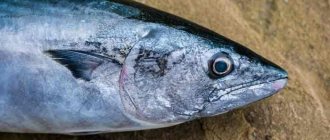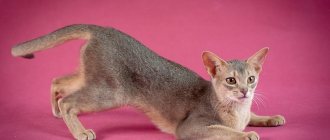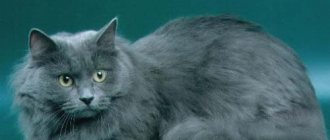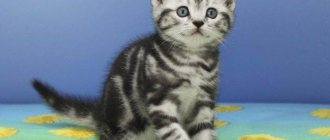Who are tree frogs?
Tree frogs, or tree frogs, are frogs that belong to the phylum Chordata, class of amphibians (amphibians), order of anurans, family of tree frogs. The researchers who discovered these frogs initially found them very beautiful. The reason for this was the peculiar color of these amphibians. The Russian-language concept of “frog” most likely appeared due to the loud voice of frogs, characteristic of representatives only of this family.
Due to the fact that these amphibians include a huge number of species, it is impossible to give a clear description of their appearance, since it is quite diverse.
Breeding
To create the necessary conditions for reproduction, it is necessary to organize a pond with standing water, shrubs and tall plants. The males climb on them and begin to sing mating songs. The female, as a rule, lays from 3 to 21 portions of eggs. From the age of 8 months, the frog is capable of reproduction and lays its eggs in the tops of tree stumps or in hollows. The future offspring are covered with a special shell. During the process, amphibians croak loudly.
After 12-15 hours, the beginning of embryo development can be observed. A few days after this, they transform into tadpoles and begin active movement. In this case, it is necessary to observe the density of their content. So, for 1 tadpole there should be 3-5 liters of water. Its temperature should be 24-26°C. You can feed tadpoles with cod liver, scalded nettle, as well as special food for aquarium fish. With plenty of food, they will grow quickly and already at the age of 1 month will reach 3-4 cm.
Important ! It is recommended to add dense peat plates as fillers to the air purification filter in the terrarium. This will increase the acidity of the water and reduce the mortality of offspring.
Australian amphibians
Representatives of the tree frog family are distributed throughout the globe. They live on every continent and on many islands. One of the subfamilies of these amphibians are Australian tree frogs. They are also called litoria.
These frogs chose Australia, the Bismarck Archipelago, New Guinea, the Solomon Islands, the Moluccas and Timor as their habitat. Since their distribution area is so large, they were given another name - Australasian tree frogs, although this is used much less frequently. The main difference between these tree frogs and others is their horizontal pupils and unpigmented eyelids.
There are currently almost 150 species of Australian tree frogs known, with new species being discovered every year. However, at the same time, many of them disappear or are on the verge of death.
Litorians, like other representatives of tree frogs, have binocular vision. The need to constantly climb trees, where they spend their entire lives, has caused them to develop sticky pads on the toes of all four paws. In those tree frogs that live on the ground, this ability is weakened or completely lost.
General information about the genus of tree frogs[edit]
Loading map... -27.059126144.4921882 300 mapquest
***
Distribution area of the genus Australian tree frogs lat. Litoria
In the biological genus of Australian tree frogs - Litoria (lat. Litoria), various researchers in the field of biology and animal taxonomy include from more than 100 to 200 species of amphibians (lat. Amphibia), distributed in various territories and in various ecological zones of the continent of Australia, in New Guinea , in New Zealand and the islands of the Malay Archipelago.
Frogs are quite large in size: some of the species reach 12–13 cm in body length, and even more than that. The pupil, in the golden-mesh iris of the eyes (which explains the later separation of some representatives into the genus - Reticularis - lat. Nyctimystes) of the tree frog "Litoria" (lat. Litoria), is located horizontally. The external color of animals varies in various shades of monotony and variegation, depending on the species. They are adapted to mimicry and easily change the tone of their skin to match the color of the surrounding space.
They lead a nocturnal and twilight lifestyle. Tree frogs spend most of their time in the crowns of trees and bushes, only occasionally descending to the ground or into a reservoir. The structure of the wide toe pads of animals allows tree frogs to reliably hold their body on vertical surfaces and move freely along steep walls and trees; they easily move along thin branches and leathery leaves of plants.
They feed on various types of invertebrates: mollusks, insects and their larvae, arachnids, and also do not disdain small birds, lizards, rodents and their young, and fish.
During dry and cold seasons, they hibernate, which can last up to 4 months a year - hiding in hollows, tree crevices and moss.
Description
Australian tree frogs, photos of which are given in the material, are very diverse. Two species living nearby may differ not only in color, but also in size. For example, the smallest among them is the spear frog, the size of which does not exceed 1.6 cm. The largest is considered the giant frog, which can grow up to 13.5 cm. Often the size and appearance of tree frogs is closely related to their habitat. Small dark individuals are more often found on the ground; they very rarely climb trees. But large green litoria live their entire lives on trees and come down from them only during the breeding season.
Flora and fauna of the Blue Mountains
Many of the plants are considered rare and endangered. They are able to live only in Australian conditions; most attempts to acclimatize them on other continents have completely failed and now they carefully preserve intact the riches of nature that exist on the Australian continent.
On the mountain slopes grow:
- tree ferns;
- mint tree;
- blue eucalyptus trees;
- Volemi pines;
- acacia
IT WILL BE INTERESTING:
Queensland - Australia
Among the long-living species of the Blue Mountains, eucalyptus trees lead the way. Volema pines were considered extinct for a long time, until the first travelers, setting off from Sydney to conquer the peaks of the mountains, discovered them on the slopes of the ridge.
Among the animals, there are several species of kangaroos, koalas, rabbit bandicoots, wombats, ring-tailed possums, swamp wallabies, spotted-tailed marsupial marten, and golden litoria. The bird world is represented by the unique cave warbler, which lives only in the Blue Mountains, fire-breasted petroicas, warty and yellow-fronted honeyeaters, diamond finches, and Wong's pigeons.
Varieties
All species of amphibians from the genus Lithorium differ significantly in their physiological characteristics, behavior and habitat.
There are so many varieties of Australian tree frogs that researchers sometimes have a hard time finding a name. Sometimes incidents arise, for example, one of the frogs is called white, although in fact its color is far from this color. It’s just that these litorii were first described by the English explorer and navigator John White (translated from English, the surname means “white”), and it was decided to name them in his honor. Only a small number of tree frogs bear the names of their discoverers.
In the vast majority of cases, Australian frogs are named for some features that are immediately noticeable or well remembered. In addition, there are species named after their habitats - Tasmanian, New Guinea, Moluccan, Cape Melville, etc. Most of the plains, rocky, cave and river frogs are named after their places of residence. Among the memorable features that gave the names to the species are the following: graceful, slender, red-eyed, green-legged, diamond-eyed, spotted-bellied, wide-faced, etc.
Many Australian tree frogs have become favorites among people interested in exotic pets. Among them, the most popular is blue or, as it is also called, white.
Reproduction
These are oviparous amphibians. In most species, direct development occurs, that is, there is no tadpole stage - small frogs hatch from the eggs. Some members of the family have forms of parental care that are unique in the animal world. Females of the genus Rheobatrachus
They swallow the hatched frogs, and they develop in the stomach until metamorphosis, after which the female regurgitates them. Male marsupial toads have peculiar pouches on their hips into which they take tadpoles after emerging from the eggs, and there the young undergo further development. Round toads and turtle frogs bury their eggs in wet sand. Other species build foam nests.
White littoria
The Australian white tree frog (also called the blue or coral-fingered tree frog) lives in the subtropical forest zone of Australia, Indonesia, and New Guinea.
Adult females of these frogs grow up to 13 cm, and males rarely reach 7 cm. They have a short and wide head, on which large bulging eyes are located. Like all Australian tree frogs, they have horizontal pupils. The color of litoria can be different - from any shade of green to chestnut or turquoise. Their entire body is covered with white or golden spots, and their abdomen is most often pinkish or white. On the inside, their legs may even be reddish-brown in color. In addition, they have sticky suckers on their toes and small membranes.
The Australian blue tree frog (or white tree frog) prefers to stay awake and look for food at night and sleep during the day. In its natural habitat it can live up to 20 years. Like most Australian litorians, the blue frog is able to adapt to its environment by changing its color. In times of danger or while hunting, she is capable of jumping over a distance of more than one meter.
Natural populations and conservation measures[edit]
Litoria's toes
The population of Australian blue frogs is not dangerous, but some measures are being taken to study and control them. Litoria are in great demand and popularity among lovers of exotic and domestic animals, and - as in most such cases, due to increasing commercial demand and the natural limitation of the distribution of individual morphological forms in the natural habitat, natural populations of frogs can decline and even disappear, disturbing thereby ecological natural balance. Strict government measures to ban and regulate trapping - the movement of animals outside of countries - can help conserve species in this case. Coral-clawed lithorii reproduce well in captivity and therefore, at present, they are not even threatened by private poaching for export and sale, either through the pet trade network of economically successful countries, or through individual small private business representatives and firms. Some wild animals are sold under the guise of the domestic population or as babies obtained from the wild form of the animal caught during the mating season.
The decline in frog populations is also affected by deforestation due to the development of industrial and agricultural production.
Keeping at home
These days it is becoming more and more fashionable to have some kind of exotic pet at home. These include tree frogs. Despite the fact that litorians are not picky, for the comfort of their living it is necessary to create certain conditions that will closely replicate the natural environment of amphibians.
Keeping Australian tree frogs requires a high vertical terrarium containing a large variety of plants. In addition, you will need to place some driftwood and vertical branches there so that the frog can climb on them. An important condition in choosing a container is that a terrarium with a volume of 40–50 liters is required for one littorium.
The bottom should be covered with a hygroscopic substrate. And also the container should have a drinking bowl and a spacious place for swimming. The optimal temperature at which tree frogs will live comfortably is 25 °C, and the humidity is not lower than 75–80%.
The Australian tree frog needs to be fed with various insects: crickets, beetles, marbled cockroaches. It is imperative to monitor the cleanliness of the terrarium: remove any remaining food, regularly change the water in the containers from which the frog drinks and bathes. It is very important to wipe the inside of the glass to remove accumulated mucus, as it can be very toxic.
Proper maintenance of a tree frog can extend its life to 22 years. Since each representative of the tree frog has its own nuances in its maintenance, you should carefully study them before purchasing a new pet.
Attractions
First of all, tourists pay attention to the delicate blue haze hovering over the slopes of the Blue Mountains. During sunrise and sunset, its color changes, creating extraterrestrial landscapes
Excursion programs to the Blue Mountains National Park include:
- inspection of the rock formations of the Three Sisters and the giant staircase, consisting of 800 steps and leading to the very top;
- Aboriginal site at Lyrebird Hollow;
- the Red Hands cave with rock paintings and handprints of ancient people;
- “singing paths” leading to sacred places;
- the Gros Valley, which is framed by 2 of the most popular routes;
- Rainbow Falls Wentworth.
In the ancient underground cave of Jenolan there are huge shafts, the bottom of which has never been seen. 9 karst cavities are open for inspection. They are illuminated in an original way, musicians are seduced by the excellent acoustics, and symphony concerts are regularly held in the caves. The botanical garden grows Jurassic pine, one of the rarest plants in the world.
At this time, nature calms down, the mountains begin to glow with a barely perceptible inner light. Against the background of almost complete silence, only the cries of the night inhabitants can be heard and the powerful, even rustle of relict eucalyptus trees can be heard, mentally transporting you many millennia ago.
IT WILL BE INTERESTING:
The main attractions of Australia
You can travel through protected areas on foot, on bicycles and all-terrain vehicles. Hiking trails resemble a tangled web; most often tourists are accompanied by guides.
Terrarium:
Type: it is better to make the terrarium narrow and tall, equipped with branches and driftwood.
Dimensions: 50x40x40 cm for one pair. For each additional animal, the volume of the terrarium is increased by 40 liters.
Substrate: a mixture of sand with peat and sphagnum moss.
Cleaning/cleaning: once every 2-3 weeks with light disinfectants.
Temperature: daytime – 24-26`C, night – 19-21`C.
Heating: required. Heating of the soil and reservoir is also desirable.
Lighting: Bright lighting, full fluorescent spectrum. Daylight hours are 10 hours.
Humidity: 60-80%. Spray water over plants and substrate 2-3 times a week. Constant air ventilation is necessary.
Plants: plant plants of different heights with dense leathery leaves - ficus, philodendron, monstera.
Pond: can be spacious and deep, but no deeper than the height of the tree frog. The water is changed once a day (the best size is 15-20 cm long and 10-13 cm deep).
Decoration: tropical forest - stones, driftwood, live (artificial) plants, pond, many hidden places.
Feeding:
You can give: live food - crickets, moths, locusts, earthworms, cockroaches, newborn mice, pieces of lean meat, frozen shrimp, fish. As a last resort, you can give a mealworm. Young tree frogs are fed small crickets, fruit flies, and other insects that the tree frog can swallow. All uneaten food is removed.
Do not feed: when fed monotonous food, amphibians develop anorexia.
Feeding frequency: adults - 2-3 times a week (no more often, since these tree frogs are prone to obesity), young (growing) - daily.
